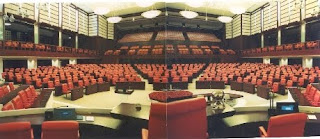Clemens Holzmeister
Clemens Holzmeister, was born in the Tyrol city of austria, who was an architect of 20th century. He studied at Vienna University of Technology and earned architecture in 1919. After he winned prize by his design, he became the head of the architecture department of Austria’s Academy of fine arts in 1924. He spent some time with building some government buildings in Ankara, Turkey.
In 1931 Holzmeister became the director of the austrian Academy of fine Arts. His journals, offices and papers seized by Nazis. Holzmeister stayed in turkey, while he designed the Turkish Parliament Building, until 1954 and then returned to Austria. He designed numerous buildings until this time in Turkey.
Generally his works included churches and semi-public buildings. He grant some important prizes.
Holzmeister repeatedly worked as a stage designer beginning in the 1930s in collaboration with Max Reinhardt for whom he created the Faust-City for the Salzburg Festival. In the 1950s Holzmeister returned to stage design and again worked for the Salzburg Festival (Don Giovanni) as well as the Vienna State Opera (Fidelio, 1955, for the opening of the renovated State Opera) and the Burgtheater.. Holzmeister is buried in St. Peter's graveyard in Salzburg.
Turkish Parliament Building
INFORMATION ABOUT BUILDING
DATE : 1939-1961
EMPLOYER : Grand National Assembly of Turkey
ARCHİTECT : Prof. C. Holzmeister,
CONSULTANTS : Latif Doğu, Adil Denktaş, Hilmi Tokmar
COST : 12 Million USD
 On 11 january 1937, it was decided to start to a project contest for the construction of a new parliament building, which would be suitable for the performance of the republic of Turkey and architectural characteristics of 21th century.
On 11 january 1937, it was decided to start to a project contest for the construction of a new parliament building, which would be suitable for the performance of the republic of Turkey and architectural characteristics of 21th century. That contest finished on 28 january 1928, in this contest there were 14 projects that participated but finally Clemens Holzmeister project was choosen. And construction of building has started on 26 october 1939.
Opening of building has become late because of 2. World War. It finished and opened for use on January 1961.
The building located on a 475,521 square meter plot of land and the settlement area of the main building is 19,372 square meters. Total space is 56,775 square meters.
The architectural chararacteristics and the general structure of the TGNA building has been designed in order to symbolize the strength and immortality of the Republic of Turkey.
The Main Building include general assemly hall administrative offices the meeting rooms of the committees, the Assembly library, the computer center, archive, offices set aside for the press and publication organizations, two large restaurants, the barber and shoeshine shops, the PTT, the airline and railroad ticket sales offices and the General Secretariat and the connected service units.
Behind the Assembly Main Building is the Public Relations Building reserved for the members of parliament where buildings and areas are found such as the covered parking lot and garage, mosque, personnel building, printing house, health center, heating center, outdoor sport facilities, greenhouse for flowers and security services.
The Public Relations Building where the working offices of the members of parliament and some of the service units are located as well was opened for service on 25 January 1984.
This building is 4 stories high and has an area of 14.000 square meters. It is composed of two separete blocks connected to each other by a bridge crossing. Furthermore, there is an underpass to the Main Building and the closed parking lot.
Comments on the TBMM
When we saw TPB( Turkish Parliament Building ) on tv , we assumed that this structure is senseless and only a stone building. But when we visit there and saw TPB buildings and its garden that were never seen before on tv, we shocked and detected many wonderful things , especially theenvironment of TPB. According to the history of turkey, TPB built in 22 years. First of all, we find this situation strange. But then , we learned that the reason of this is the condition of the world war II. But although these situations were happen in past , now TPB is associated with many differ flowers , grass and trees. It represents the revolutions of the M.K.ATATÜRK. The security level of the TPB is too high as well Anıtkabir. For example, the security of building is provided by both military service and police. Moreover, they did not give the plan of TPB , because of the safety of government. But they give some general and historical information about TPB building and functions. Finally, all parts of TPB are really so excited and are worth seeing .








